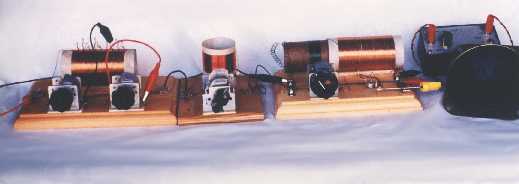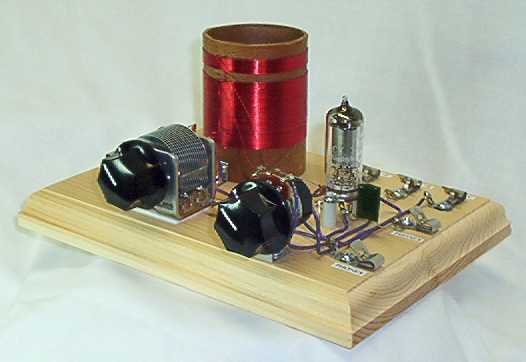BORDEN RADIO COMPANY
WWW.XTALMAN.COM
*********
CUSTOM WOODCRAFT BY JUAN IRACHETA
**************************************
BUILD A MORGAN ANTENNA TUNER KIT!!
A GREAT ACCESSORY FOR CRYSTAL RADIOS, TUBE RADIOS, AND LOW POWER AMATEUR TRANSMITTERS!!
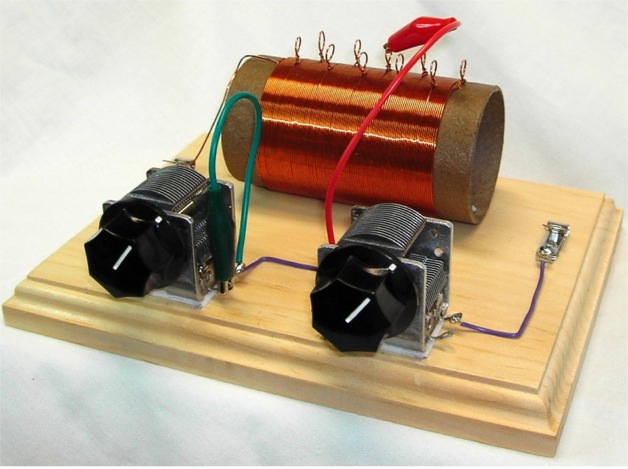
Alfred P. Morgan was a prolific early writer of books on the subjects of electricity, wireless telegraphy, and radio. His works were written for young people and the average man who was not an expert in mathematics and physics. His book, THE BOY ELECTRICIAN, originally published in 1913 and many printings after, taught many a youngster how to make crystal radios, wireless transmitters, antennas, and all kinds of electrical experiments. Many young people who built Morgan's projects later became engineers and scientists. This great little antenna tuner is named after Alfred P. Morgan for his influence on the lives and careers of many people. In the early days of wireless, very low frequency, very long wavelength signals were used. These extremely long wavelengths required exceptionally long antennas in order to be resonant. It was impractical to have antennas that were thousands of feet long, so early designers found a way around this problem by using "loading coils" to artificially lengthen their antennas. These loading coils were adjustable coils of wire, or Inductors. A variable capacitor was often added in parallel with the loading coils to "fine tune" their shorter antennas to the resonance of a much longer antenna. During the 1920s, amateur radio experimenters discovered that shorter wavelength signals would "skip" off the Ionosphere and thus allowed very long distance communications using low transmitter power on the "Short Wave" bands. Many antennas were too long to resonate at these shorter wavelengths. The designers found that a variable capacitor connected in-series with the antenna allowed it to be tuned to resonance at the higher frequency short wavelengths. Because we like to operate on multiple frequencies, loading coils with parallel-connected variable capacitors and series capacitors were combined into one circuit and were then called "Antenna Tuners." The Morgan Crystal Radio Antenna Tuner works to tune random wire antennas from approximately fifty feet and longer for crystal sets and more complex radios on the A.M. Broadcast Band, Short Wave and Amateur Bands up to about 30 MHZ. By tuning your antenna to resonance, it will transfer the energy from the received radio wave to your set more efficiently. This will result in a louder signal that will allow weaker "DX" stations to be heard that were not audible before. This antenna tuner can also be used to increase the selectivity of simple receivers. This feature helps to separate the faint DX stations from the strong locals. Building this antenna tuner is accomplished using simple assembly techniques and high quality parts. The air variable capacitors are the same fine American-made units that we use on our Armstrong One Tube Radio Kits, Dunwoody High Performance Crystal Radio Kits, and Bucher Crystal Radio QRM Rejectors. This kit is based on our ELECTRONICS HANDBOOK Magazine article, "How To Build And Use A Crystal Set Antenna Tuner", reprints of which are available in our "Literature" Link. This is an improved version of that antenna tuner. Clip-leads are used for the coil tap connections and for shorting the series capacitor when it is not in use. The clip-leads simplify construction and eliminate the signal-robbing losses that result from the use of a rotary switch and its many leads. Very good results can be expected with this antenna tuner. It has been used successfully used with our Dunwoody High Performance Crystal Radio and with our Armstrong One Tube Radio. It also works well with our Cornell WW-II Foxhole Radio and our Pickard Crystal Radio. It has been used with antique radios and commercial communications receivers. In addition to this, it can be used with low power "QRP" amateur radio transmitters with an output below 10 watts to match the transmitter's output impedance to an end-fed wire antenna. One customer says, "This antenna tuner will increase the number of A.M. DX stations received on a one-tube set ten-fold!" Highest quality parts are used throughout. The pre-drilled routed baseboard is made for us by TOLEWOOD.COM from clear furniture grade basswood that can be stained for an attractive vintage look. The pre-punched coil form is made from the same heavy cardboard shipping tube as our Dunwoody High Performance Crystal Set. Quality black Bakelite knobs contribute to the vintage appearance. Nickel-plated brass fahnestock clips are used for the input and output connections. All parts, screws, clip-leads, and wire are included in this fine quality kit. The easy-to-understand instructions were designed for beginners, however the coil winding is at a level of difficulty for more experienced builders. Soldering is required.
Complete kit including all parts and easy to follow instructions:
$74.95 each
These great kits are now available for immediate shipping!
*****************************************
BUILD A BUCHER CRYSTAL RADIO QRM REJECTOR!!
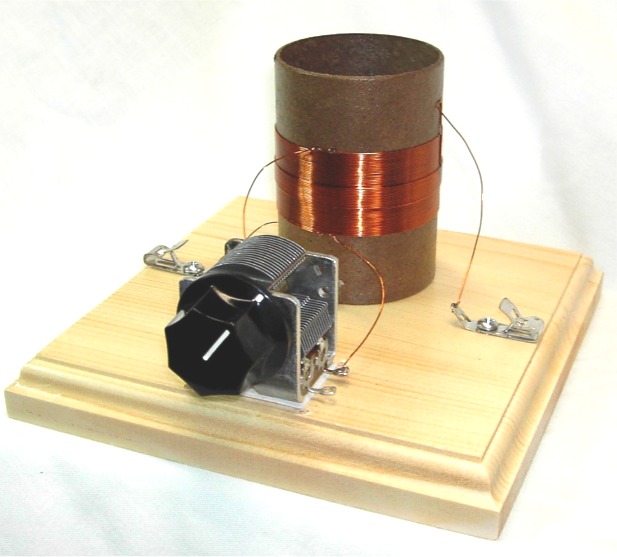
Elmer E. Bucher (pronounced, 'boo-cher') was an instructing engineer at the Marconi Wireless Telegraph Co. of America in the very early pioneering days of radio just after the turn of the Twentieth Century. Mr. Bucher was a great mentor to thousands of early amateur and professional operators in the fields of wireless telegraphy and radio. His mentoring was so well known that even today, Radio Amateurs who mentor novices in getting their "Ham" licenses are commonly called, "Elmers." His book, PRACTICAL WIRELESS TELEGRAPHY, was published from 1917 to 1920 and covered everything from batteries and magnets to setting up and operating a complete wireless station. In his own words, "The author has endeavored to give the non-technical student and the practical telegraphist an understanding of the functioning of present day commercial wireless telegraph apparatus"
Complete kit including all parts and easy to follow instructions:
$54.95 each
These great kits are now available for immediate shipping!
***************************************
BUILD A DUNWOODY HIGH PERFORMANCE CRYSTAL SET RADIO KIT!!
U.S. Army Signal Corps General Henry H. C. Dunwoody received a patent for the carborundum crystal detector in 1906. This work paved the way for later crystal detector inventions. This fine crystal set kit was named after General Dunwoody for his contribution to the science of radio and electronics. The circuit is based on a very selective and sensitive design that has been used since the very early wireless days. It employs an antenna/ground tuning capacitor to fine tune the input to the parallel tank tuning circuit for optimum selectivity and signal level. The air variable capacitor tuned parallel tank circuit is then adjusted to resonate at the desired frequency. The combination of these two air variable capacitor tuned circuits makes this set perform far and away better than regular single-tuned, or slider-tuned crystal sets. The air variable capacitors are the same fine American-made units that we use on our Armstrong One Tube Radio Kits. This kit is based on our ELECTRONICS HANDBOOK Magazine article, "Build A High Performance Crystal Set", reprints of which are available in our "Literature" Link. This is an improved version of that radio. The tapped coil circuit allows selection of frequencies from below the bottom of the A.M. Broadcast Band all the way up to about 12 MHZ in the Short Wave bands. It is common to be able to hear real DX from short wave broadcast stations thousands of miles away when conditions are right. It is a real thrill to hear the BBC London, Radio Netherlands, Radio Taiwan, and others on a CRYSTAL SET! The performance on the AM Broadcast Band is also exceptional. It is possible to hear AM stations hundreds of miles away when conditions are good. One inovation in this circuit is the Detector Tap Cliplead. This feature allow you to select the point on the coil where the signal level is highest for the crystal detector. This point varies with the frequency to which the set is tuned. Most crystal sets have a fixed detector connection that does not allow for this performance enhancing feature. Highest quality parts are used throughout. The pre-drilled routed base board is made for us by TOLEWOOD.COM from clear furniture grade basswood that can be stained for an attractive vintage look. The pre-punched coil form is made from heavy cardboard shipping tubing like our other sets. Quality black bakelite tuning knobs contribute to the vintage appearance. The 1N34A Germanium crystal detector is hand selected and tested for greatest sensitivity. The use of Detector Fahnestock clips allows the use of external detector stands. Enough room has been designed into the detector area to allow installation of a detector stand on the board in place of the germanium diode, if so desired. We sell vintage detector stands in our "Detectors" Link on this web site. Nickel plated brass fahnestock clips are used for all connections. All parts, screws, washers, sandpaper, and wire are included in this fine quality kit. The easy-to-understand instructions were designed for beginners, however the coil winding is at a level of difficulty for adults or more experienced young builders. Soldering is required. This set requires a high impedance magnetic headset or ceramic earphone available on the "Headsets, Earphones...." An outside antenna kit is available from us for $34.95.
Complete kit including all parts and easy to follow instructions:
$79.95 each
These great kits are now available for immediate shipping!
******************************************
BUILD AN ARMSTRONG ONE TUBE SET RADIO KIT!!
This little radio is the distillation of many circuits for one tube sets that have appeared since Edwin Armstrong invented the regenerative circuit in 1912. It uses the best features of many famous one tube sets and has features not found on most radios of its type. One such feature is the capacitor coupling of the audio output . This feature prevents the "B" battery voltage from passing through the headset and possibly ruining the magnets. It also allows direct connection to amplifiers without further circuitry and also allows the use of ceramic earplugs when connected in series with a 10K ohm resistor. The capacitor coupling makes the detector more stable and reduces the "hand capacity" effect, thus making regeneration adjustment much easier. Another feature is the autotransformer type coil that allows better coupling of the signal from the antenna and helps prevent the antenna circuit from loading down the detector and making it tune broadly. The tuning of this little radio is very sharp for a one tube set. Only the finest of components are used. One example is the vintage style air variable capacitor. These are custom made from an old design by skilled American craftsmen in U.S.A. They are very precise and smooth. No other one-tube set sold today offers all of these special features. Battery life is outstanding. The 3S4 vacuum tube filament only draws 50 milliamps so the "A" battery, consisting of two standard "D" cells, will last many hours. The "flywheel" effect of the regenerative circuit causes the "B" battery life to be even longer; lasting hundreds of hours. The "B" battery consists of five standard 9 volt batteries. The Armstrong One Tube Radio covers the Standard A.M. Broadcast Band from 550 KHZ to 1700KHZ. Its powerful circuit pulls in amazing BCB DX from hundreds of miles away. Builders of this radio have reported distances over 1500 miles when conditions are right. One builder reported that, "The Performance is AWESOME!" You will love building this little jewel. It is easy to construct and the directions are very easy to understand and follow. Nothing can compare to the thrill you will have sitting in a darkened room, lit only by the barely perceptible glow of the single vacuum tube, while listening to your favorite shows, or distant DX stations, on this little Armstrong One Tube Radio that you built by yourself. These great looking, high quality vintage style radios are designed to be just like homebrew radios that were built in the 1940s and 1950s by radio hobbyists in the great vacuum tube era. Only the best vintage type parts are used. The special parts kits contain the American Made air variable tuning capacitor, in-circuit tested N.O.S. 3S4 vacuum tube, tube socket, fahnestock clips, solder lugs, resistors, capacitors, regeneration potentiometer with switch, coil form, mounting brackets, stand-offs, screws, magnet wire, hook-up wire, knobs, battery holder for "A" batteries, battery clips for "B" batteries, and the fine quality ready-to-finish routed basswood plaque for the base. Everything is included to build your own Armstrong One Tube Radio except the batteries, headset and antenna. Soldering is required. This set comes with a high impedance magnetic earphone. You can also use the Telex 600 Ohm Dunamic Double Headset that we sell on this website. An outside antenna is necessary for optimum performance. An outside antenna kit is available from us for $34.95. Order one today! With U.S. Priority Mail, it will be at your home in two or three days! You can put it together in one or two enjoyable evenings and then you can have years of pleasure listening to it and looking at it!
Complete kit including all parts and easy to follow instructions:
$89.95 each
These great kits are now available for immediate shipping!
BUILD A PICKARD CRYSTAL SET RADIO KIT!!
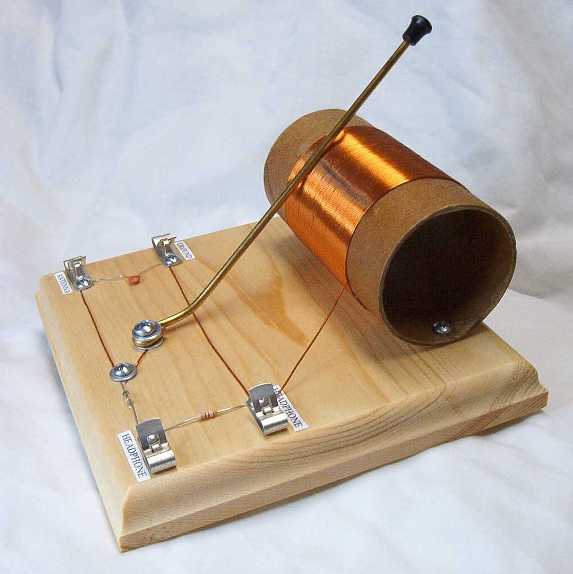
Greenleaf Whittier Pickard invented the crystal detector in 1906. This crystal set kit was named after him in his honor. The original Pickard Crystal Set Radio Kit was designed for a Rice University class on Amateur Radio for eight-to-twelve year olds that was presented at the Houston, Texas, Museum of Natural Science. This is an improved version of that kit. High quality parts are used throughout. The pre-drilled routed base board is made from clear furniture grade pine that can be stained for an attractive vintage look. The pre-punched coil form is made from heavy cardboard shipping tubing like the Uncle Al's crystal sets of the 1920s. This material will stand up to practically anything imaginable. A solid spring brass rod is used for the tuning slider. It will not bend or loose its tension. A black flaired knob has been added to contribute to the vintage appearance. The 1N34A Germanium crystal detector is hand selected and tested for greatest sensitivity. Nickel plated brass fahnestock clips are used for all connections. A current path resistor is used for the earphone for best volume and fidelity. A ceramic capacitor in the tuning circuit provides great selectivity for a slider tuned crystal set. A sensitive ceramic earphone is included with the kit. All parts, screws, washers, sandpaper, and wire are included in this fine quality kit. This crystal set far outperforms the cheap cardboard & plastic kits that are presently available in stores, catalogs, and on-line. This is a quality kit that a kid can build today and show to his grandkids many years from now. The easy-to-understand instructions were designed for beginners. This is the perfect kit for Cub Scouts and all other kids no matter what their age! No soldering is required. This set comes with a high impedance ceramic earphone! Nothing else to buy except an outside antenna kit that is available from us for $34.95.
Complete kit including all parts and easy to follow instructions:
$34.95 each
These great kits are now available for immediate shipping!
******************************************
BUILD A CORNELL WW-II FOXHOLE RADIO KIT!!
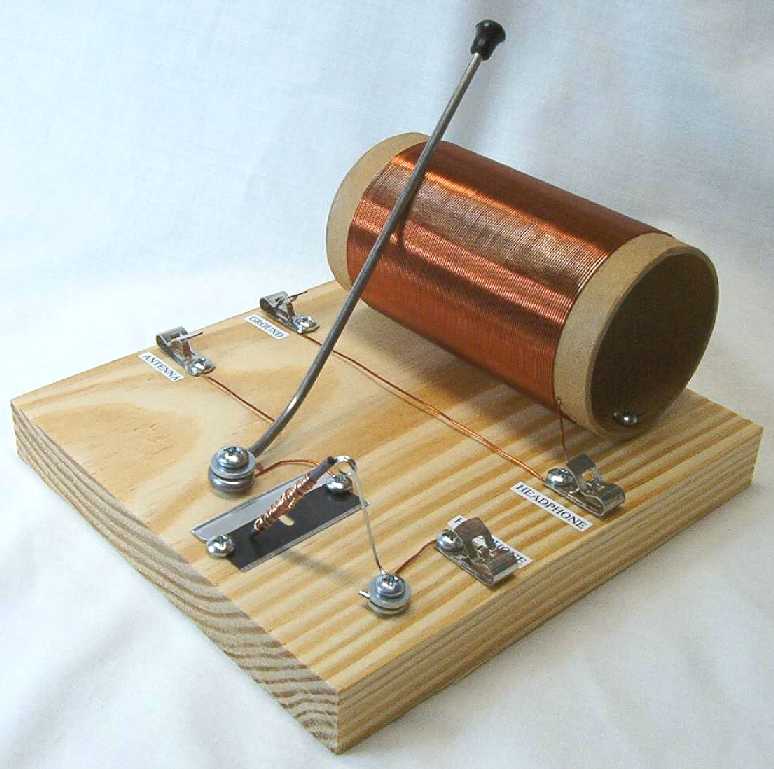
A number of our customers have expressed interest in learning about the simple little razor blade radios that were built by American soldiers to use in their foxholes on the battle fields of Europe and the Pacific during World War II. These radios were essentially crystal sets that used blue razor blades for detectors because crystals were almost impossible to obtain under the conditions the G.I.s faced in those days. In the early 1940s, tube type portable radios were fairly large and used short-lived, expensive batteries that would have been hard to find in the field. Also, the Germans had sensitive, radio direction finders that could pick up the local oscillators of superheterodyne portable receivers. They could use these devices to home in on the locations of the Allied emplacements in order to direct artillery and aircraft fire. Because of this, it was forbidden to use portable superhets on the front. Still, the G.I.s had the desire to listen to news, entertainment, and the "all-important" baseball scores, along with other sports. Battles did not rage constantly and sometimes there were many hours and even days when they had to sit in their foxholes and wait out the boredom. Most locations were close enough to radio stations to receive them with simple sets.
Many of the G.I.s were radio hobbyists before the war and they had the knowledge to make simple radios out of junk they found around them. Many of them knew that materials other than crystals could be used to detect radio waves. Headsets, wire, screws, and washers could be scrounged off of blown-up vehicles. Pieces of board came from ammo and supply boxes. Toilet paper tubes were usually available for use as coil forms and it was easy to find pencils and safety pins. The word got around through the "grape vine" and many soldiers made these radios even if they didn't understand how they worked. The Nazi Propaganda Ministry, oversaw the operation of powerful broadcast stations that targeted the U.S. Forces with American Swing music, such as the popular Glenn Miller, and of course, there was the infamous Axis Sally. The music was good on these stations and it wasn't hard to ignore the Nazi propaganda. If one were really lucky, he would be able to get the U.S. Armed Forces Radio Service. This network carried many popular shows, news, sports, and music from back home - and in English to boot!
Several people wrote in to QST magazine about foxhole radios during World War II. Among those was young Lieutenant Paul M. Cornell, W8EFW, who wrote of a design he used in the Pacific in 1945. It was one of the first such articles that mentioned using a pencil lead for a contact. This Borden Radio Company kit is named after him in appreciation for his article in the September, 1945 issue of QST Magazine.
High quality parts are used throughout. The pre-drilled base board is made from clear pine that is not unlike the wood from ammo boxes and "C" Ration crates the G.I.s could get in the battlefield. The pre-punched coil form is made from heavy cardboard shipping tubing that gives the appearance of the G.I.s toilet paper tubes, but is much stronger and will stand up to many years of use. A solid steel rod is used for the tuning slider. This is similar to the wire used in WW-II to bind ammo crates together. A black flaired knob is used for moving the tuning rod. The PAL Single Edged Blue Razor Blade detector is just like the blades that many soldiers used for their radios. Nickel plated brass fahnestock clips are used for the antenna, ground, and headset connections. A sensitive ceramic earphone is included with the kit. All parts, screws, washers, sandpaper, and wire are included in this fine quality kit. This is a great kit that a kid of any age can build and learn about the simple radios the soldiers built so long ago. A brief history explains the facts about how these radios came about and how they were used by the G.I.s in World War II. The easy-to-understand instructions were designed for beginners. No soldering is required. This set comes with a high impedance ceramic earphone. Nothing else to buy except an outside antenna kit that is available from Borden Radio Company for $34.95. . .
Complete kit including all parts and easy to follow instructions:
These great kits are now available for immediate shipping!
******************************************
All Borden Radio Company products are sold plus U.S. Priority or First Class shipping according to your Zip Code plus $2.00 handling in USA. Please email us your address for the cost of shipping.
(outside U.S.A. please email for shipping cost)
1. For Mail Orders : Email us and tell us what you want to order and we will reply with your total including shipping & handling and our mailing address.
2. For Credit Cards: Email us and tell us what you want to order and your address and we will reply with your total including shipping & handling, Then click on the PayPal logo below and follow their simple instructions for sending money. You will need our PayPal address. Our PayPal address is wb5rex@earthlink.net
******************************************
More Kits Coming As We Get Time To Introduce Them!!
(This page was revised 06/30/2023)
